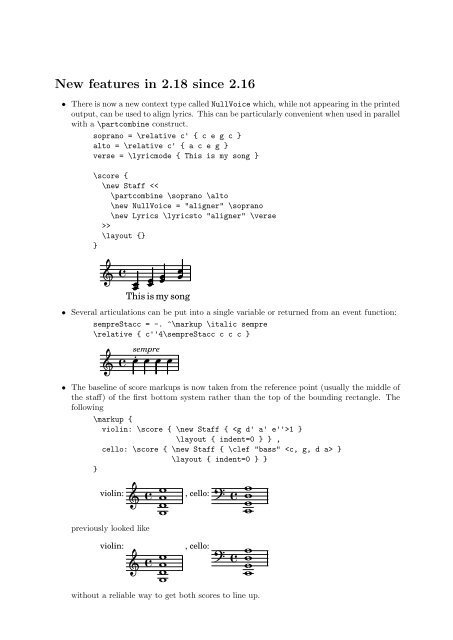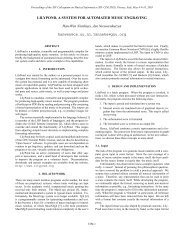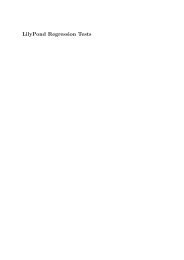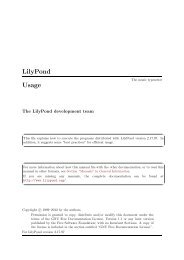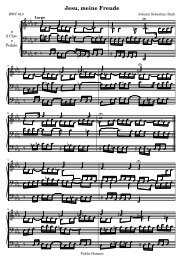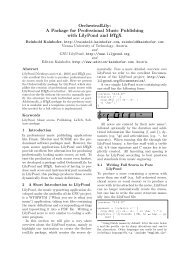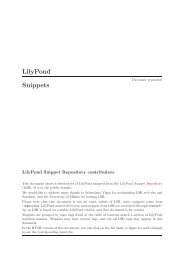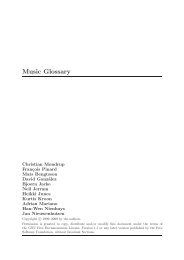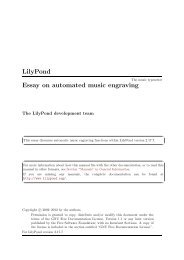Changes - LilyPond
Changes - LilyPond
Changes - LilyPond
You also want an ePaper? Increase the reach of your titles
YUMPU automatically turns print PDFs into web optimized ePapers that Google loves.
New features in 2.18 since 2.16<br />
• There is now a new context type called NullVoice which, while not appearing in the printed<br />
output, can be used to align lyrics. This can be particularly convenient when used in parallel<br />
with a \partcombine construct.<br />
soprano = \relative c' { c e g c }<br />
alto = \relative c' { a c e g }<br />
verse = \lyricmode { This is my song }<br />
\score {<br />
\new Staff ><br />
\layout {}<br />
}<br />
<br />
<br />
<br />
<br />
<br />
<br />
This is my song<br />
• Several articulations can be put into a single variable or returned from an event function:<br />
sempreStacc = -. ^\markup \italic sempre<br />
\relative { c''4\sempreStacc c c c }<br />
<br />
<br />
sempre<br />
<br />
• The baseline of score markups is now taken from the reference point (usually the middle of<br />
the staff) of the first bottom system rather than the top of the bounding rectangle. The<br />
following<br />
\markup {<br />
violin: \score { \new Staff { 1 }<br />
\layout { indent=0 } } ,<br />
cello: \score { \new Staff { \clef "bass" }<br />
\layout { indent=0 } }<br />
}<br />
violin:<br />
<br />
previously looked like<br />
violin:<br />
<br />
<br />
<br />
<br />
, cello:<br />
, cello:<br />
<br />
<br />
<br />
<br />
without a reliable way to get both scores to line up.
• <strong>LilyPond</strong> no longer automatically infers a ‘\defaultchild’ context in a context definition<br />
with ‘\accepts’ clauses. Any context definition without an explicit or inherited<br />
‘\defaultchild’ definition counts as a ‘Bottom’ context and will be eligible for rhythmic<br />
events and overrides without causing the implicit creation of other contexts. Be sure<br />
to specify a ‘\defaultchild’ for non-‘Bottom’ contexts when defining them from scratch.<br />
• There is now extensive support for both discant and bass accordion register symbols in the<br />
‘scm accreg’ module, see Section “Accordion Registers” in Notation Reference.<br />
#(use-modules (scm accreg))<br />
\new PianoStaff<br />
<br />
}<br />
>><br />
<br />
<br />
<br />
<br />
<br />
<br />
<br />
<br />
<br />
<br />
<br />
<br />
<br />
<br />
<br />
<br />
<br />
<br />
<br />
<br />
<br />
<br />
b<br />
<br />
<br />
<br />
<br />
<br />
D<br />
<br />
<br />
<br />
<br />
am<br />
<br />
<br />
• New commands markLengthOn and markLengthOff control the allowance of horizontal space<br />
for tempo and rehearsal marks.<br />
C<br />
B<br />
<br />
<br />
<br />
<br />
<br />
gm<br />
<br />
a<br />
<br />
A<br />
Molto vivace<br />
<br />
<br />
A<br />
Meno mosso<br />
16<br />
B<br />
<br />
<br />
A Meno mosso<br />
Molto vivace<br />
<br />
<br />
16<br />
B<br />
<br />
• Rehearsal marks at the beginning of a line are now placed to the right of the clef and key<br />
signature by default. As in previous versions, the break-alignable-interface controls<br />
the behavior.
72<br />
4<br />
3<br />
K Adagio<br />
…<br />
• Decimal numbers can now be written directly in music, without a hash sign. Together with<br />
the previous change in the way object properties are specified, the code to change the length<br />
of stems has changed from this:<br />
to this:<br />
\override Stem #'length = #5.6<br />
e' f' g' a'<br />
\override Stem.length = 5.6<br />
e' f' g' a'<br />
One has to write a digit on both sides of the dot – values like 4. or -.3 are not allowed.<br />
Decimal fractions are also not accepted in \chordmode.<br />
• A number of shorthands like (, ), |, [, ], ~, \(, \) and others can now freely be redefined<br />
like normal commands. An example would be<br />
"\\{" = (<br />
"\\}" = )<br />
"(" = \melisma<br />
")" = \melismaEnd<br />
\new Staff
that choice was somewhat arbitrary, recommended usage was to always specify the reference<br />
pitch.<br />
• A new command \single can be used for converting a property override into a tweak to<br />
be applied on a single music expression:<br />
1<br />
<br />
• A new command \temporary can be applied to overrides in order to not have them replace<br />
previous property settings. If a \revert is applied to the same property subsequently, the<br />
previous setting reappears:<br />
\override NoteHead.color = #red c4<br />
\override NoteHead.color = #green d<br />
\revert NoteHead.color e2<br />
\override NoteHead.color = #red c4<br />
\temporary\override NoteHead.color = #green d<br />
\revert NoteHead.color e<br />
\revert NoteHead.color c<br />
<br />
<br />
<br />
<br />
<br />
This is mainly useful for writing music functions that need to have some property changed<br />
just for the duration of the function.<br />
• \tag, \removeWithTag, and \keepWithTag can now accept a list of symbols rather than<br />
just a single symbol for marking, removing, and keeping music with any of multiple tags.<br />
This is particularly important for \keepWithTag since one cannot achieve the same effect<br />
by using multiple consecutive \keepWithTag commands.<br />
• The ‘-d old-relative’ option has been removed. Not actually accessible from the command<br />
line any more, its remaining use was for interpretating \relative in <strong>LilyPond</strong> files<br />
converted automatically from version 1.8 or older. It is unclear how much of this was<br />
actually still operative.<br />
• The meaning of instrumentTransposition has been reversed. After<br />
\set instrumentTransposition = #{ b #}<br />
a written c' now sounds like b. Previously, this would have been the other way round.<br />
This and the following change should make dealing with transposing instruments more<br />
straightforward.
• The music generated by \set and \override commands is no longer affected by<br />
\transpose. The main consequence is that \transpose will transpose audible/concert<br />
pitch and printed pitch by the same amount even when the transposed music contains<br />
\transposition. Previously,<br />
\transpose c' f' \transposition bes'<br />
was equivalent to \transposition f'. Now it stays equivalent to \transposition bes'.<br />
• When checking for collisions, <strong>LilyPond</strong> no longer treats objects as rectangles. Instead, the<br />
actual shape of objects is approximated using an integral-like approach. This generally<br />
results in more even and snug positioning of objects and systems:<br />
<br />
<br />
f<br />
<br />
f<br />
<br />
f<br />
<br />
<br />
<br />
<br />
<br />
<br />
<br />
r'venu... T1<br />
<br />
<br />
<br />
Previously, the above snippet looked like this:<br />
<br />
<br />
f<br />
<br />
f<br />
<br />
f<br />
<br />
<br />
<br />
<br />
<br />
<br />
<br />
T1<br />
r'venu...<br />
<br />
<br />
<br />
Affected objects include Accidentals, Beams, Clefs, Dynamics, FiguredBass, Flags,<br />
Glissandos, Lyrics, MetronomeMarks, OttavaBrackets, Pedals, RehearsalMarks,<br />
Rests, Scripts, TextScripts, Ties, Tuplets and VoltaBrackets.<br />
• Tuplets are now created with the \tuplet command, which takes a fraction t/n to specify<br />
that t notes are played in the time usually allowed for n. One \tuplet command can create<br />
several tuplet groups if their duration is typed after the fraction.<br />
\tuplet 3/2 { c8 d e } \tuplet 3/2 { f e d } c2<br />
\tuplet 3/2 4 { c8 d e f e d } c2<br />
<br />
<br />
<br />
3<br />
<br />
<br />
<br />
3<br />
<br />
<br />
<br />
<br />
3<br />
<br />
3<br />
<br />
The \times command with its inverted fraction order n/t is still available.<br />
• Introducing two new markup-commands; \draw-dashed-line and \draw-dotted-line.<br />
The dashed-line extends to the whole length given by dest, if full-length is set to #t (this<br />
is the default) without any space at the beginning or end. off will then be altered to fit.<br />
To insist on the given (or default) values of on, off use \override #'(full-length . #f).<br />
Manual settings for on, off and phase are possible.<br />
The dotted-line always extends to the whole length given by dest, without any space at<br />
the beginning or end. Manual settings for off are possible to get larger or smaller space<br />
between the dots. The given (or default) value of off will be altered to fit the line-length.<br />
\markup {<br />
\draw-dashed-line #'(5.1 . 2.3)<br />
\override #'(on . 0.3)<br />
\override #'(off . 0.5)<br />
\draw-dashed-line #'(5.1 . 2.3)<br />
\draw-dotted-line #'(5.1 . 2.3)
}<br />
\override #'(thickness . 2)<br />
\override #'(off . 0.2)<br />
\draw-dotted-line #'(5.1 . 2.3)<br />
• Starting with version 2.17.10, error messages or the textedit URI used for point-and-click<br />
functionality specify column numbers starting with 1 rather than 0. The byte offset (also<br />
part of textedit URIs) still starts at 0.<br />
• The \clef command supports optional transposition:<br />
\clef "treble_(8)"<br />
c2 c<br />
\clef "bass^[15]"<br />
c2 c<br />
<br />
(8)<br />
<br />
<br />
<br />
[15]<br />
<br />
<br />
<br />
• The <strong>LilyPond</strong> syntax of dot-separated words Voice.Accidental has been made interchangeable<br />
with #'(Voice Accidental), a Scheme list of symbols. As one result, code<br />
like<br />
\override Voice.TextSpanner #'(bound-details left text) = "rit."<br />
is now equivalent to<br />
\override Voice.TextSpanner bound-details.left.text = "rit."<br />
or even<br />
\override #'(Voice TextSpanner) bound-details.left.text = "rit."<br />
• Grob and grob property path no longer need to be specified as two separate arguments to<br />
commands like ‘\override’ and \revert, allowing for the syntax<br />
\override Voice.TextSpanner.bound-details.left.text = "rit."<br />
Since complementary music functions like ‘\overrideProperty’ cannot support forms with<br />
and without separating space at the same time, using a single dotted path is now the<br />
preferred form. Specifying grob path and grob property path separately, currently still<br />
supported with ‘\override’ and ‘\revert’ for compatibility reasons, is deprecated.<br />
• Due to words now being accepted as symbol function arguments, the interfaces of<br />
‘\accidentalStyle’, ‘\alterBroken’, ‘\footnote’ and ‘\tweak’ had to be redesigned<br />
where optional symbol arguments were involved. Please check the respective music function<br />
documentation for details.<br />
• Several commands now accept symbol lists (conveniently entered as dot-separated words)<br />
for various kinds of arguments. These include ‘\accidentalStyle’, ‘\alterBroken’,<br />
‘\footnote’, ‘\hide’, ‘\omit’, ‘\overrideProperty’, ‘\shape’, and ‘\tweak’.<br />
• The bar line user interface has changed. Bar glyphs now resemble the appearance of the bar<br />
line, so a left repeat sign has to be coded as .|:. The command \defineBarLine provides<br />
an easy way to define additional bar line styles.<br />
• Accidentals in the key signature may be printed in octaves other than their traditional<br />
positions, or in multiple octaves.


